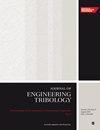Predictions of friction and temperature at marine cam-tappet interface based on mixed lubrication analysis with real surface roughness
IF 1.8
3区 工程技术
Q3 ENGINEERING, MECHANICAL
Proceedings of the Institution of Mechanical Engineers, Part J: Journal of Engineering Tribology
Pub Date : 2023-07-18
DOI:10.1177/13506501231188758
引用次数: 0
Abstract
The working conditions of cam-tappet pairs in marine diesel engines are directly influenced by the engine output power, the operational speed, the temperature, as well as the components surface micro-morphology, etc., which cause the cam-tappet pairs work in the mixed lubrication state, thus the interfacial friction, pressure and temperature rise are vital to engine performance, efficiency, and durability. An interfacial friction–temperature prediction model for the cam-tappet pairs, considering the effects of transient working conditions and the real surface roughness, is developed in the present study, based on the theories of the transient mixed EHL and the heat transfer under the condition of a fast moving heat source. The numerical results of surface temperature rise are compared with those from the Blok formula, and a good agreement is found. The obtained results show that the presence of 3D roughness may lead to a decrease in the lubricant film thickness, and the surface temperature rise of tappet may exceed 700 K, which is close to the material scuffing temperature, causing the surface failure due to scuffing and wear. If increasing the cam speed and base circle radius within certain range, it may lead to the increment of film thickness and reduction of surface temperature rise, thus the lubrication effectiveness is increased. In addition, using cast aluminum bronze may significantly reduce the surface temperature rise and improve the interfacial characteristics.基于混合润滑分析和实际表面粗糙度的船舶凸轮-挺杆界面摩擦和温度预测
船用柴油机凸轮-挺杆副的工作状态直接受到发动机输出功率、转速、温度以及部件表面微观形貌等因素的影响,导致凸轮-挺杆副工作在混合润滑状态下,因此其界面摩擦、压力和温升对发动机的性能、效率和耐久性至关重要。基于瞬态混合EHL理论和快速热源条件下的传热理论,建立了考虑瞬态工况和实际表面粗糙度影响的凸轮-撑杆副界面摩擦温度预测模型。将表面温升的数值计算结果与Blok公式的计算结果进行了比较,两者吻合较好。结果表明:三维粗糙度的存在会导致润滑膜厚度减小,挺杆表面温升可能超过700k,接近材料磨损温度,导致表面磨损失效。在一定范围内增大凸轮转速和基圆半径,可使油膜厚度增加,表面温升减小,从而提高润滑效果。此外,使用铸铝青铜可以显著降低表面温升,改善界面特性。
本文章由计算机程序翻译,如有差异,请以英文原文为准。
求助全文
约1分钟内获得全文
求助全文
来源期刊

CiteScore
4.20
自引率
5.00%
发文量
110
审稿时长
6.1 months
期刊介绍:
The Journal of Engineering Tribology publishes high-quality, peer-reviewed papers from academia and industry worldwide on the engineering science associated with tribology and its applications.
"I am proud to say that I have been part of the tribology research community for almost 20 years. That community has always seemed to me to be highly active, progressive, and closely knit. The conferences are well attended and are characterised by a warmth and friendliness that transcends national boundaries. I see Part J as being an important part of that community, giving us an outlet to publish and promote our scholarly activities. I very much look forward to my term of office as editor of your Journal. I hope you will continue to submit papers, help out with reviewing, and most importantly to read and talk about the work you will find there." Professor Rob Dwyer-Joyce, Sheffield University, UK
This journal is a member of the Committee on Publication Ethics (COPE).
 求助内容:
求助内容: 应助结果提醒方式:
应助结果提醒方式:


